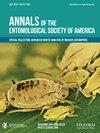巴西东北部田蝇(双翅目:田蝇科)居群调查:全球害虫sativae和huidobrensis的mtDNA分析
IF 1.8
3区 农林科学
Q1 ENTOMOLOGY
引用次数: 1
摘要
摘要:密蚜蝇属(双翅目:密蚜科)分布于世界各地,是具有重要经济价值的叶虫。然而,一些害虫种群虽然形态非常相似,但mtDNA序列却存在高度差异,这表明名义种实际上是隐种的复合体。本研究的重点是两种全球入侵害虫,L. huidobrensis (Blanchard)和L. sativae Blanchard,已知对巴西作物具有高度破坏性,尽管对它们的形态和遗传差异的研究很少。利用巴西东北部6种作物(吉非瓜、菊花、甜瓜、西瓜、番茄和洋葱)巴西种群的线粒体细胞色素氧化酶I (COI)和细胞色素氧化酶II (COII)共63个序列,与美洲、欧洲、亚洲、非洲和澳大利亚的可用序列进行了遗传结构分析。遗传结构与寄主植物和地理位置均无相关性。两种基因的种内总体遗传分化程度较低。另一方面,L. sativae的高种内差异及其系统发育位置证实了目前仅在巴西发现的分化分支,并表明它可能是一个全球性的隐种复合体。考虑到潜在物种的可能性(在后一种情况下),我们为这些全球害虫的未来研究和当地管理提供了这些巴西种群的详细重新描述。最后,我们的结果还揭示了本文提出的一个新同义词,L. strigosa Spencer是L. huidobrensis的初级同义词。本文章由计算机程序翻译,如有差异,请以英文原文为准。
Investigating Liriomyza (Diptera: Agromyzidae) Populations From Northeastern Brazil: mtDNA Analyses of the Global Pests L. sativae and L. huidobrensis
Abstract Species of Liriomyza Mik (Diptera: Agromyzidae) occur worldwide and are economically important leafminers. However, populations of some pest species, although very similar morphologically, show highly divergent mtDNA sequences, suggesting that nominal species are in fact complexes of cryptic species. This study focuses on two globally invasive pests, L. huidobrensis (Blanchard) and L. sativae Blanchard, already known to be highly destructive in Brazilian crops, although only a few studies on morphological and genetic divergences of them have been made. A total of 63 sequences of the mitochondrial cytochrome oxidase I (COI) and cytochrome oxidase II (COII) from Brazilian populations of L. huidobrensis and L. sativae collected from six crops (gypsophila, chrysanthemum, melon, watermelon, tomato, and onion) in Northeastern Brazil were generated to investigate their genetic structure together with available sequences from the Americas, Europe, Asia, Africa, and Australia. Genetic structure was not found to be correlated to neither host plant nor geographical locality. Liriomyza huidobrensis showed an overall low intraspecific global genetic divergence in both genes. On the other hand, high intraspecific divergences for L. sativae and its phylogenetic position confirm a divergent clade currently found only in Brazil and suggest it may be a global complex of cryptic species. Considering the possibility of cryptic species (in the latter case), we provided detailed redescriptions of these Brazilian populations for future studies and local management of these global pests. Finally, our results also revealed a new synonym herein proposed, L. strigosa Spencer as a junior synonym of L. huidobrensis.
求助全文
通过发布文献求助,成功后即可免费获取论文全文。
去求助
来源期刊
CiteScore
4.90
自引率
0.00%
发文量
25
审稿时长
6-12 weeks
期刊介绍:
The Annals of the Entomological Society of America exists to stimulate interdisciplinary dialogue across the entomological disciplines and to advance cooperative interaction among diverse groups of entomologists. It seeks to attract and publish cutting-edge research, reviews, collections of articles on a common topic of broad interest, and discussion of topics with national or international importance. We especially welcome articles covering developing areas of research, controversial issues or debate, and topics of importance to society. Manuscripts that are primarily reports of new species, methodology, pest management, or the biology of single species generally will be referred to other journals of the ESA. The most important criteria for acceptance are quality of work and breadth of interest to the readership.

 求助内容:
求助内容: 应助结果提醒方式:
应助结果提醒方式:


